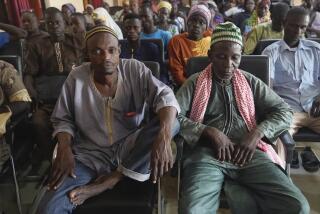A Country That Still Lives Its Tortured History
- Share via
EAST SETAUKET, N.Y. — In the Kivu region of eastern Zaire, 1 million refugees are fleeing warfare and rebellion. It is one of the worst humanitarian emergencies in modern history, certainly deserving of media attention and of the hand-wringing efforts by the international community to help.
This is just one tragedy, though, in a much larger disaster that engulfs the entire country of Zaire and its 45 million people. Zaire, which borders nine other countries and is the centerpiece of Africa, is falling apart.
It is a disaster long in the making, beginning in the era of colonial greed and ending after decades of Cold War strategizing, during which the United States used Zaire as if a giant pawn. The troubles on its eastern border with Rwanda and Burundi are but symptoms of the greater malaise that has come to a head under the dictatorship of Mobutu Sese Seko.
The performance of the Zairian army in Kivu is one such symptom. Its soldiers, men in uniform with a mission to protect the helpless, pillaged the offices and commandeered the vehicles of international relief agencies. They fled before a force of rebels, deserting the key town of Goma, whose airport served as a lifeline for the refugees.
The reaction of Zaire’s citizens to the fall of Goma is another symptom. They looted the stores and the dictator’s palace there, throwing worthless Zairian currency in the air like confetti and dousing themselves with Mobutu’s imported perfumes.
This ignominious behavior, of army and citizen alike, is the result of a broken economy, a crumbled infrastructure and a corrupt government whose only surviving efficiency is repression. Zairians are struggling along by means of what they call Systeme D, a phrase taken from debrouillardise, a French word meaning resourcefulness.
Salaries no longer exist or are rendered negligible because of astronomical inflation. To make ends meet, civil servants sell permits for buildings, teachers sell passing grades, physicians sell medicines from public hospitals, nurses sell beds, police stage robberies. The surprise is not that Zaire is coming undone but that it has survived this long.
Zaire’s tortured history began in the late 15th century, when the Portuguese sailed down Africa’s west coast and found the Kongo Kingdom, one of the great Iron Age civilizations. They forged an alliance of trade and the exchange of ideas with the Africans. Then the Portuguese discovered that great fortunes could be made by selling their allies into slavery. Central Africa became a major supplier of slaves and its indigenous civilizations were ruined.
Four centuries later, when the European colonial powers divided up Africa, the Belgian King Leopold took its center as his personal colony, the Belgian Congo. The king coerced the Congolese into a peonage whose purpose was the production of rubber, which was in great demand as the Industrial Revolution got underway. The king’s agents enforced rubber-gathering quotas by cutting off the hands and ears of delinquents or shooting them, men and women.
International outrage at the Leopoldian system resulted in the Belgian government taking over the colony at the outset of the 20th century. The new rulers ran the Congo on forced labor and refused to prepare its people for independence, even prohibiting them from attaining higher education.
Still, independence, when it came in 1960, stirred hopes that the country would become one of Africa’s richest, a nation endowed with minerals, forest, farmland and the immense hydroelectric potential of the Congo River. Instead, Zaire has steadily disintegrated under Mobutu, a Zairian version of King Leopold.
Mobutu, as any Zairian not in the dictator’s pay will say, is the biggest thief of all. Since coming to power in 1965, he and a clique of insiders have systemically plundered the domain. Mobutu himself has amassed a fortune of at least $5 billion. He has invested much of it in Europe, as well as in the 10 palaces he owns in Zaire.
Mobutu has succeeded in maintaining his “kleptocracy,” as Zairians call their government, until now because of two principal reasons: his ruthlessness and U.S. support. The dictator grabbed power with the blessings of the CIA, which secured the arrangement by helping to kill Patrice Lumumba, the first democratically elected leader in the country and in Africa. Ever since, he has overseen a security apparatuses specializing in the massacre, torture and imprisonment of dissidents or suspected opponents.
U.S. actions can be explained by the seeming exigencies of the Cold War. Both Washington and Moscow saw Zaire as a strategic prize because of its central location in Africa and its mineral reserves. Mobutu could be counted on for his pro-Americanism and his ability to quell unrest. An end was put to rebellions in Shaba and in eastern Zaire, where followers of Lumumba, bolstered by ragtag rebels, threatened the newly gained U.S. hegemony.
For the next quarter century, the United States stood at Mobutu’s side, economically and militarily aiding him, and providing him with international legitimacy. When conditions under his dictatorship worsened, U.S. ambassadors would show up in Kinshasa, the capital, with mandates for Mobutu to clean up his government and allow his people some freedom. Mobutu did neither. The United States rationalized his regime with the increasingly self-fulfilling argument that he was the only person capable of holding the country together.
Mobutu played the good Cold War soldier, allowing his country to be used as a safe haven and weapons conduit for proxy wars fought in Angola and Chad. At the United Nations, Zaire was the one African country that always could be counted on to support U.S. initiatives.
Earlier this decade, Mobutu agreed to a transition to democracy, which he has since thwarted. At one point, Zaire had two governments, one headed by an elected prime minister, whom Mobutu locked out of his office, and another nominally headed by one of the dictator’s henchmen.
Yet, the time has long since passed to redeem Mobutu. He has been in Europe since late summer, under treatment for cancer in Switzerland and now trying to recuperate in the luxury of one of his estates in southern France.
The Zairian people are left to survive or rebel. The leaders of the Kivu rebellion have made it clear that their seizure of Goma and a strip of territory along Zaire’s border with Rwanda and Burundi are not isolated events, that they are in contact with disaffected Zairians in other regions and want, ultimately, to end Mobutu’s dictatorship.
A thousand miles west of Kivu, protesters in the main streets of Kinshasa are demanding the resignation of Mobutu’s latest hand-picked prime minister. In the side streets, armies of rats attack uncollected piles of garbage, children go famished and epidemics of cholera fuel on the filth. In the south, the diamond-producing province of Kasai has all but broken away from the central polity, having established a separate currency, university and self-help governance. Toward the west, Shaba province has almost ceased its vital copper production and insurrection against the central government is a favorite topic.
This rebelliousness is reminiscent of the country’s mood at independence. But with the Cold War over and the country no longer a geopolitical asset, Zaire may well be left to flounder and disintegrate on it own, for once.*
More to Read
Sign up for Essential California
The most important California stories and recommendations in your inbox every morning.
You may occasionally receive promotional content from the Los Angeles Times.










